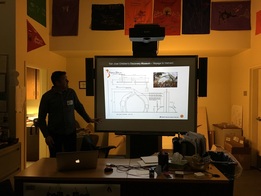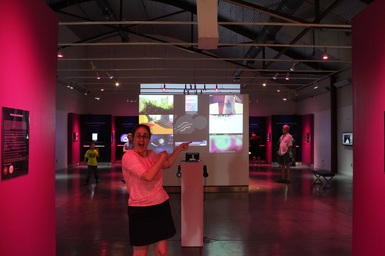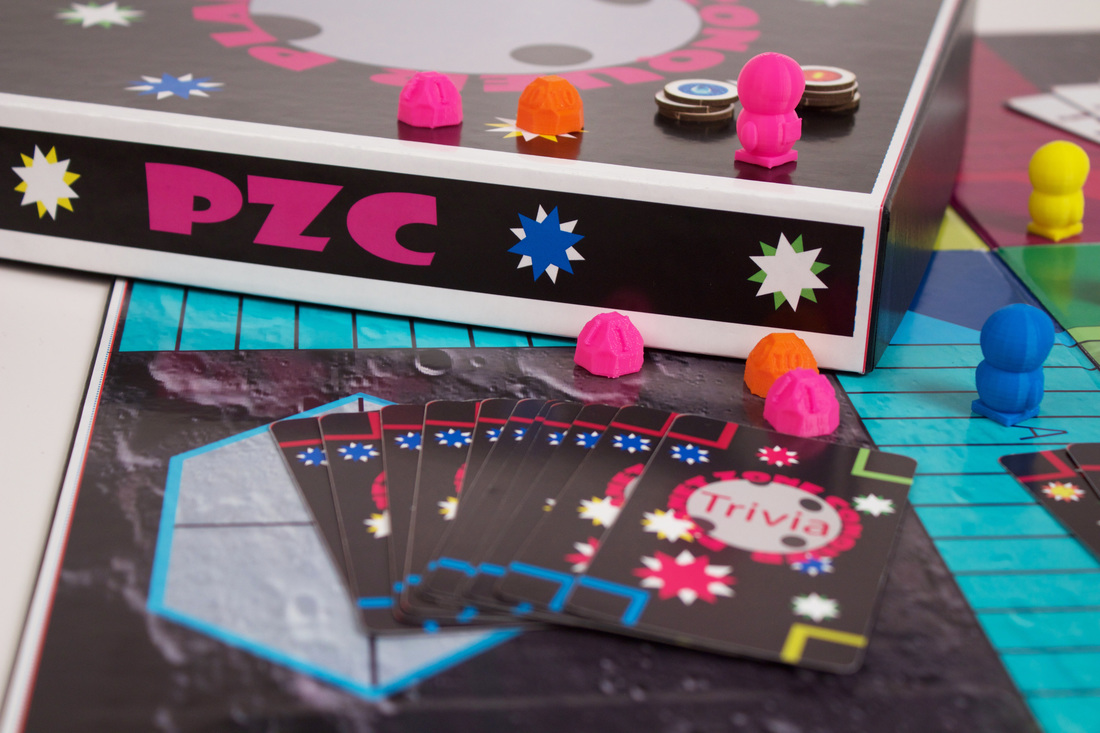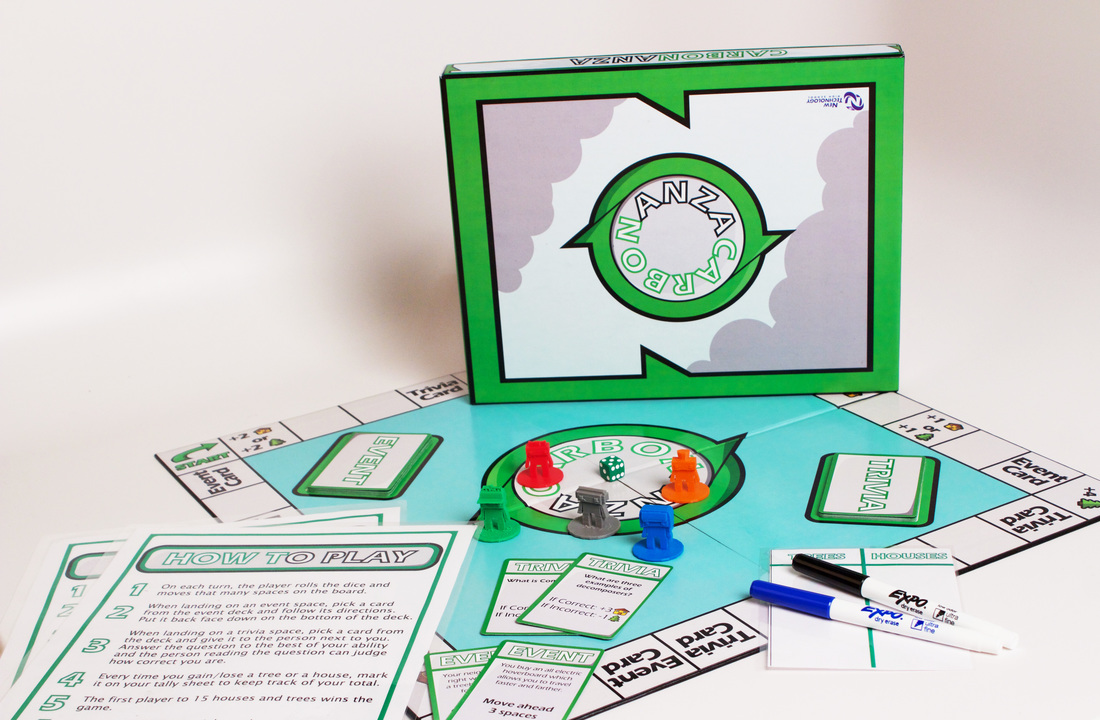|
We've started our annual board game project in my Game Design and Visual Effects class at New Tech. This year we are collaborating with the Psychology students to create board games that educate about mental health disorders. We are partnering with local mental health organizations and hope to use the games to help educate the public and those who have been diagnosed to better understand these issues:
Students were allowed to choose the disorder that they wanted to work with and it's no surprise that those with certain issues wanted to be the Subject Matter Experts for their team. This blog is about one such student who lives every day with Attention Deficit Hyperactivity Disorder. E. started out having a hard time finding his place in the project. He struggled with the 3D modeling tutorials I provided for students to learn Maya. But one day he came in with a fidget and asked if he could try to model the fidget. "Sure! Let's see what you can do!" He set out to make his fidget, working off something he had prototyped at home with a piece of a ruler. He had cut a hole in the ruler the size of a ball bearing from one of his old skateboards and could turn the ruler slice around and around in his hand. As a student with ADHD, having a fidget can be beneficial to helping with focus in class. This is also true for those who have Sensory Integration Dysfunction. The Switch Went On! For the next week E. spent every moment he could in front of the computer and the 3D printer making iteration after iteration. Every step along the way, he would show other teachers and students what he was up to. Frankly, it just had that cool factor to it, a weight and feel that was so satisfying. He started collected pre-orders from staff and students alike and got some startup money for his creations from the Assistant Principal. His math teacher wanted in on the action. "How do I get him this fired up about Math?" She tried looking at fractions and ratios in relation to his fidget. You know what else would be cool, E? What if we made this your player piece for your board game and there has to be some game mechanic that involves each player fidgeting with their game piece? What if you created places to put tokens in the fidget so that as you progress with the board game, you can put the tokens in the fidget? Now his whole team was excited about the project and a board game idea was born: Fidget to Finish. It is still under construction, but there is now extra excitement to make sure the board game matches the fidget in it's function and level of interactivity. Moments We Live ForThere are moments when we as teachers are so excited to see a student find their passion. This was one of them. Ultimately, it takes a whole lot of flexibility to find the sweet spot for each student. But when it happens, mmm, mmm, mmm. What really excites me is the idea that we are creating a board game to help others understand what students with ADHD need to succeed. And E. is a living example of that. AND, I'm buying a fidget when they are ready for sale just so I can fidget in class too. Update: May 12, 2017Here's the finished board game! A group of 3 ADHD students and one who does not have that mental health issue COMPLETED their board game, on their own. An amazing accomplishment for all involved. They were really happy with the final result and so was I. We are working on getting the 3D print files to upload to thegamecrafter.com so you can buy the board game and print your own playing pieces (spinners.)
2 Comments
Today is the day that our final product from Game Design came to fruition. I can't believe that this actually happened. About six months ago, the curator from the Napa Valley Museum, Meagan Doud, called New Tech High, looking for interns to help with a future exhibit about Indie Games. They sent the call to me, thank goodness! At that time, I boldly suggested that instead of recruiting a few interns, why didn't we just have the two Game Design classes I teach take on the exhibit as a school project? I had no idea how awesome it would be! I took the idea to the students and asked permission to let go of the last project of the year, which was to center around coding and drones. Some were reluctant, because, hey, who doesn't love tinkering with drones? But most saw it as an opportunity to do something real and substantial, related to the Game Industry, a field that about half of the 45 students were interested in entering upon graduation from high school, or college. We split the teams up into different sections, some covering music, art, 3D modeling, video, interactivity, early childhood educational components, game mechanics and game careers. Students picked their own areas of interest and away we went. We met with the curator every two weeks, either in person, or via Skype to review questions, status reports and next steps. Two students, one from each class, came to me and asked if they could be the overall project managers. Could they essentially be in charge of the exhibit? Um....yeah! They happened to be two seniors, one who is pursuing Game Design in college next year, and one who wanted to try on the mantle of leadership. Every team also had team project managers (PMs), who were responsible for communicating with the other team PMs, the Lead PMs and with Meagan. There were several PM meetings outside of class to make sure that everyone was on the same page with the project.  Students were asked to consider several target audiences, ranging from families with small children up to attendees from the Veteran's home on the same campus as the museum. Together, we learned about project management skills, from Gantt charts, to Scrum Meetings, to managing resources and deadlines, to using the Design Thinking Method to get clear about prototypes and deliverables. This was a hefty, real world project. It also turns out that we have a New Tech parent who designs exhibits for a living! At the last moment, he jumped in to show off his own work and help the Game Design students really think deeply about how to best engage exhibit visitors. In addition, students learned about 3D modeling, motion graphics, 2D graphics, color theory, writing for signage and exhibits, research, game mechanics and game careers, prototyping, video filming and editing, presenting, and above all, collaboration. I really do hope, that if you are in the area, that you stop by and see the exhibit. It turned out better than I ever could have hoped and I am SO proud of the work that we ALL did together. "Down the Rabbit Hole" runs from July 15, 2016 through January 8, 2017 at the Napa Valley Museum in Yountville, CA, in the Napa Valley and it features 10 Indie Games. There are some great movie nights and Family Fun Days offered, including a Retro Game Marathon, Model Building, Learning about Binary Code and Pixel Art. Look at the very bottom of the blog post for the info. on the show and activities. For me, finding authentic learning projects is a personal passion, and I am convinced that they can not only be done, but done well, can give students real-world experience, and can provide the impetus for some amazing learning. If you have questions for me about authentic learning projects, you can always contact me on twitter @lisagottfried or leave a comment on this post and I'll get back to you. When experiencing or learning a new technology for the classroom, the first questions that come to mind for me include: Why would I use this technology? How does it make my students, better, faster, smarter? Does this make life easier for me or the students or are there more obstacles than value for learning? Would a more low-tech answer still get the same results? Does the new technology engage all of the senses? Is the technology just a "fancy pencil" or does it deepen learning or interaction? If students use this technology, how will it change the interaction with the material? What new paths will open up by using this technology? Will student use of this technology better prepare them for their futures in college or career or is the technology becoming obsolete? Will this new technology last and be adopted by others out in the world or is it a passing phase? Virtual Reality: TPACK Game Changer or Passing Phase?Recently, my high tech-hubby bought an HTC Vive, for business purposes. But, we've been having great fun putting it through it's paces and trying all the games that are currently available for the headset including a 3D painting program, a Myst-like puzzle game, a bow-and-arrow game, some shooter games and a fun game where you shield yourself from spheres of light as you rock out to the music. It's all a LOT of fun.
I have to wonder, though. Is this where education is heading? Are we going to wind up like the characters in Ready, Player, One, where the teachers are virtual, the students go to a virtual school and they take virtual field trips, all through their VR headsets? It's all going to depend on whether or not the audience for VR can grow past the current projected figures of 300,000 - 500,000 for this year. Learning in a VR environment would certainly change every item in the TPACK model, from pedagogy, to content and knowledge to the very context in which learning happens. I see so many possible applications for the VR headsets, but as of now, wearing the devices can only be done for short periods of time, (it gets sweaty) and it's not a social thing yet. You are using the device alone, moving through spaces alone and interacting with computer generated entities alone. But I could see teaching people all about certain body movements through VR. It's the old wax-on, wax-off approach. Want to learn martial arts? Bat away a ton of sparkling balls of light in the right way, and you will soon have the muscle memory for defending yourself with out-blocks and in-blocks. Want to work out your body to increase muscle tone? What if you played a game that took you through an entire work out while you played. In teaching more academic content, want to learn about Mars? Why not go there? Why not orbit for a while before landing on the surface to explore? Learning about history? Go visit the Palace of Versaille or a Medieval Castle, or better yet, live like a serf or a courtier. Fully immersive technology, if it does catch on, will completely change what, where and how we teach. Whether it's Virtual Reality or Augmented Reality, if the technology progresses and is adopted, the future of our classrooms will be totally different than the way they are now. Permit me to kvell. In Yiddish that means to gush over great things, things you are proud of. So, here I am kvelling. My students really succeeded this year in making some incredible board games that teach about the carbon cycle. They worked with professional board game designers, energy experts in the industry, and Environmental Studies students as they developed, tested and implemented their games over a four-month period. They were aided, in part, by the Innovation in the Classroom grant awarded to us from the California Education Research Association. The grant helped to purchase a new Makerbot 3D printer, filament for the printer, and professional printing services. What you see here are the results of a well-honed project, deeply steeped in real world applications of game design, 3D modeling and printing, 2D design, and project management. Most students were surprised at how long it took to develop a game and really do it right, complete with many iterations and rounds of play testing. They also were appreciative that whatever skills they learn in board game creation, can be transferred to video game creation. Most video game industry experts I consulted with say that necessary skills for video game creation include a strong understanding of game mechanics, game play, and knowledge of how to write a game design document, all skills that students learned as they developed their board games. They used Autodesk Maya, Adobe Illustrator, Photoshop, google drive and www.thegamecrafter.com to execute their games and I'm blown away by the finished products! They've now got a strong project that they can use in their portfolios as they move forward into the professional fields of their choice. Check out the photo gallery below to see our entire process from beginning to end. Students spent a huge amount of time this year game testing, critiquing, and adjusting their prototypes to make sure that the game play was engaging and easy to understand. They also learned about color pallets, branding, and writing rulesets that are easy to follow.
Next year, we will have the honor of marketing and selling these board games across the country to science teachers everywhere. Know someone who might be interested? Let me know and we'll contact them when we are ready to bring these to market! Or maybe you are teacher who wants a game developed to teach particular content? Comment below and we'll see if we can collaborate! I am so grateful to be able to do these sorts of high level projects with my students at New Tech High. They are amazing designers and learners and I enjoyed every minute of this project with them! Let's look at what other teachers are doing in the classroom. I will use three different case studies to explore ways in which other teachers are successfully engaging students in learning through the use of technology. All three case studies are live-linked. Take a look at them yourself if you'd like to learn more!  AccorEpic Fail or Win? Gamifying Learning in My Classroom A professor in Teacher Education used a series of game-based learning strategies to help students master skills and processes. She used the 3Dgamelab and Gradecraft to help implement her strategies. Students could choose "quests" that took 20-25 minutes each to earn badges and experience points. I was drawn to this case study because I currently use a game-based learning app, Classcraft to work on classroom behavior issues, but do not use it to teach and track learning. The piece I am most interested in pursuing in terms of augmenting my own use of classcraft has to do with how to use the software to personalize learning. According to the article: "Personalizing Learning The software provided large amounts of data on each student, allowing me to identify skills they were working on, how long they spent on a quest, badges earned, and standards met, as well as reading their feedback on each quest. All this data was used to further personalize and scaffold learning paths." I know that Classcraft has a quest function and I would like to explore that option further. I like the idea of taking the attention off of grades and more on learning and this approach seems to help with this. The professor knew that students were learning when they completed the quests set forth for them. Per the professor's own words, "I gamified my classroom in the hopes that students would no longer ask about their grades. Ultimately, students did focus more on academic and grit skills (especially when I began returning quests instead of simply assigning low grades to mediocre submissions). " I found this article to be very helpful with tips, tricks and very specific recommendations on how to gamify the classroom. I rate this article 4 out of 5 even though it was more of an article than a case study.  Social Media: Making Connections Through Twitter In this video, there were many different ways that social media was used to create connections, from teacher to teacher within a school district, students to student within the district, connecting students globally and locally, and connecting students to experts in their fields of study. There is clear evidence of learning happening on so many levels with social media. For example, one student tweeted a question to an astronaut and to NASA. "Can you see the night and day line from space?" a student asked Thornton when they were studying night and day. They both responded. They answered not only that question but others as well, and tweeted back a picture." Students are excited to see that people are engaging with them, and that they can get responses from experts, like NASA. "They do appreciate the fact that people are responding to what they do," one teacher says. When a teachers's class was studying simple machines a few years ago, one of his students asked, "What about a straw? Would a straw be like one of the simple machines?" To aid their class discussion about the materials they were using, on teacher called attention to the drinking straw by tweeting out, "Would the straw be an example of one of the six simple machines?" This sparked an online debate between scientists around the globe and the students in that class were able to see that online conversation unfold. I think the most exciting piece of this process has to do with students' questions being valued, heard and answered so quickly from a variety of experts. It lends a sense of authenticity and reward that is often missing when questions arise in class. I know that, in my Digital Media classes, we often have technical questions that come up. Just last week, as students were submitting their game board projects to thegamecrafter.com to send the game to print, a handful of them encountered problems with uploading their files. The sizing of the files was off by a pixel and no matter how they tried to fix it, they were not getting results. Frustration was clearly mounting. I went on with a few students and entered the chat room on thegamecrafter and asked for help. Not only did we get our questions answered within seconds, but, about five professional board game designers became very curious as to what we were doing in class. It opened up conversations in ways that seem to blow the walls off of schools and I'm very excited to try more of this with Twitter. Next time an interesting question pops up, I am going to stop what we are doing and open up the discussion to the rest of the world through social media. I like the idea of deepening the discussion, lending credibility to the original question and creating outside relationships with experts in their industries. This can be implemented tomorrow in my classroom and I think that will be my plan! I rate this case study 5 out of 5!
In this study, not only where students asked to teach the class an important concept, but they were also asked to make sure that they addressed many different learners buy presenting a slide show, coupling that with handouts or notes that require some fill-in-blank spots to keep students engaged and creating a place for students to process the information through pencil and paper. Then students were asked to create some kind of engaging activity such as a crossword puzzle, word search, game or other interactive approach.
I personally love when my students are asked to bring something new to the class to learn and share that knowledge with us all. Last week I had one student teach about Bartyl's Taxonomy in Game play and one student teach about how the brain learns when we play video games. Both of these talks were highly engaging and seemed to keep the attention of ALL of my game design students. After looking at this case study, I think I would like to more formally introduce this idea of students bringing their own lessons to the class and have them think through their presentation more deeply. I did notice that after both presentations, there was a lively discussion about the subject matter that seemed to engage most of the students in the class. It was a pleasant reminder that we ALL can benefit from taking on the teacher role and that asking a student to do more than just get up and talk asks them to stretch themselves as teachers and learners. I know I can put more structure in place in my classes to support this concept and allow students to shine. It's a very authentic way of assessing and practicing Oral Communication. I just wish I had videotaped both presentations. They were so good and shared information that I knew nothing about! It's so awesome to learn something new from my students! I give this case study as 4 out of 5. Today was the day. It happens every year. We roll the dice in Classcraft and today, pulled the random event that sets certain odd behaviors and actions into motion in my class. What normally is a very talkative class became eerily silent this morning. For all of about 10 minutes. And then all havoc broke loose as students figure out how to "game the game." Then we got to listen to speech-to-text computer voices saying the lyrics to really bad songs. Then new students chimed it by talking to each other from across the room via speech to text. It wasn't long before teenage humor mayhem took over.
There was much giggling. And more interaction between students than ever, as they prepared to present their new game prototypes to another class this week. Those who often float under the radar, sitting off to the side texting their friends, where now texting their team mates about the project. Why? Because they could. There is an inherent playfulness that I relish, in any learning environment. How do we cultivate this in all of our classrooms? Find games to play....at EVERY opportunity. We sang Karaoke this morning in my Digital Media class, which led to students humming and singing through the rest of class, a nice way to wake up on a Monday morning! We tossed coins on a big answer poster on the floor, from across the room as a formative assessment. Students begged me for another quiz question! Scratch off tests. Game Boards. Bingo. Trivia questions. Name that Tune. Thumb wrestling. (Look up Massive Multi-player thumb wrestling for a great short whole class game.) It doesn't matter what it is. Gamification is where it's at when it comes to increasing student engagement. |
AuthorLisa Gottfried is a CTE teacher with 20 years experience as CEO of her own Video and Motion Graphics Production house. She currently teaches Digital Design at New Technology High School and at Touro University in the Masters of Innovative Learning program. She loves her job and her students! Archives
January 2024
Categories
All
|























 RSS Feed
RSS Feed
